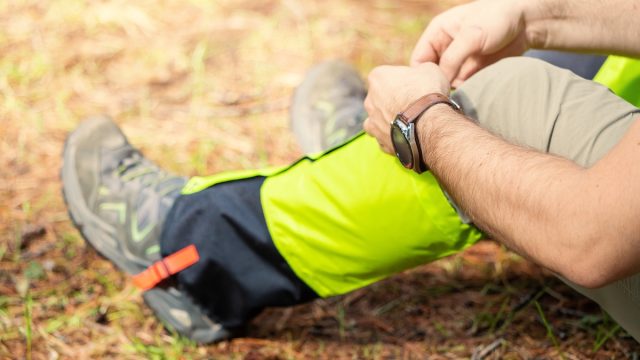The Best Things to Wear to Protect Yourself During Rattlesnake Season

From hiking and camping to planting flowers in your garden, there’s no shortage of fun springtime activities that get you outside and enjoying nature. Of course, you’ll have to stock up on the essentials like sunblock, a trusty water bottle, energy snacks…and snake chaps?
Earlier this month, the San Jacinto County Office of Emergency Management in southeast Texas issued a “stark reminder” that snakes are becoming more active and cautioned folks to “be vigilant” of their surroundings when exploring the great outdoors. And now, The Denver Gazette is sharing four wardrobe tips to protect yourself during rattlesnake season.
RELATED: 5 Surprising Places Rattlesnakes Like to Hide Around Your Home.
Most rattlesnake bites occur around the feet and ankles, which is why sandals or open-toe walking shoes should never be worn on hiking trails, especially those lined with rocks, shrubs, or other grassy areas that make excellent hiding places for snakes.
Instead, opt for thick socks and hiking boots or durable tennis shoes, per the news outlet. Ensure your footwear is made from sturdy materials and covers your ankles.
“Keep in mind that some snakes can still penetrate leather and rubber. That’s why it’s essential to pick a pair of boots that are labeled as heavy-duty, so they are thicker than everyday leather and rubber boots,” explains Stone Creek, an online clothing store specializing in outdoor gear.
While you’re stocking up on wool socks and shoes with a tough-as-nails exterior, The Denver Gazette also suggests getting a high-quality pair of recreation gloves. To keep your wrists and fingers safe, look for gloves made of “tightly woven nylon,” says Stone Creek.
“Gloves can also be helpful if moving around brush in a spot where a rattlesnake might be lurking,” according to The Denver Gazette. Rattlesnakes aside, gloves can also protect your hands from sharp branches, poison ivy, and other lurking critters.
If you’re going hiking or camping in a state known for its dense rattlesnake population (Arizona has over 10 native rattlesnake species, for example) it may also be worth investing in a pair of snake chaps or snake gaiters.
“Snake chaps are designed…to be a thick layer of protection that helps block a snake’s fangs from penetrating during an attack,” explain Stone Creek. They’re often made from “heavy duty nylon, as well as a mix of nylon, polyester, denim, and heavy-duty ballistic fibers.”
While snake chaps cover the entire leg (from ankle to thigh), snake gaiters go to just below the knee and are built to protect the top of your shoe, ankles, and calves.
RELATED: First Rattlesnake Bite of the Year Prompts Urgent New Warnings.
Your apparel matters, but other non-wardrobe practices can keep you safe this rattlesnake season, too.
For instance, if you encounter a rattlesnake out in the wild, the best thing you can do is “stay calm and give it plenty of space,” says The Denver Gazette.
“A rattlesnake’s strike distance can be up to one third to one half of its overall length,” warns Denver Health. “Avoid provoking a rattlesnake. Avoid poking it, kicking it, throwing rocks, or trying to annoy the snake. A threatened or scared snake is more likely to strike back releasing extra venom.”
Although this may seem obvious, it’s also smart to know how to identify a rattlesnake. The health agency describes rattlesnakes as reptiles with “flat, triangular shaped heads” and “tan and brown patchwork.” Their pupils are typically hooded and you’ll notice “openings between the nostrils and eyes.”
Another important reminder: Not all rattlesnakes will make themselves known audibly. Therefore, the U.S. Forest Service advises sticking to well-known hiking trails, avoiding tall grasses and weeds where snakes could be hiding, not turning over rocks or logs, and never putting your hands where you cannot see.